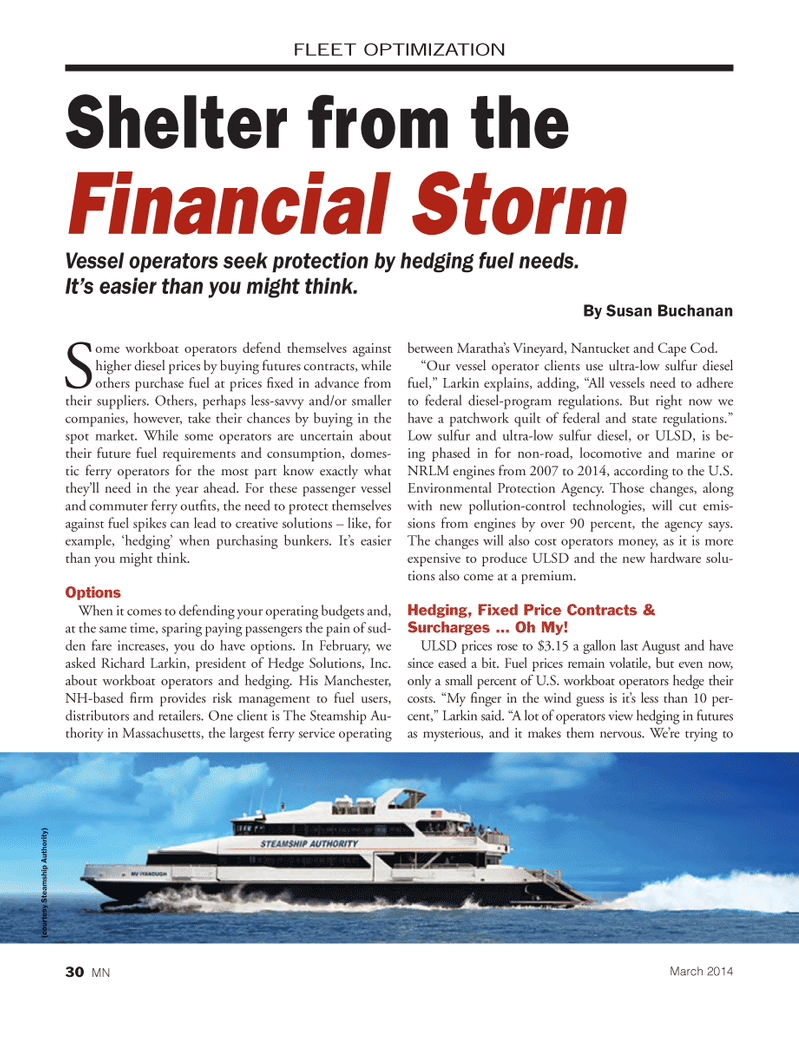
Page 30: of Marine News Magazine (March 2014)
Fleet & Vessel Optimization
Read this page in Pdf, Flash or Html5 edition of March 2014 Marine News Magazine
S ome workboat operators defend themselves against higher diesel prices by buying futures contracts, while others purchase fuel at prices fi xed in advance from their suppliers. Others, perhaps less-savvy and/or smaller companies, however, take their chances by buying in the spot market. While some operators are uncertain about their future fuel requirements and consumption, domes- tic ferry operators for the most part know exactly what they’ll need in the year ahead. For these passenger vessel and commuter ferry outfi ts, the need to protect themselves against fuel spikes can lead to creative solutions – like, for example, ‘hedging’ when purchasing bunkers. It’s easier than you might think.
Options
When it comes to defending your operating budgets and, at the same time, sparing paying passengers the pain of sud- den fare increases, you do have options. In February, we asked Richard Larkin, president of Hedge Solutions, Inc. about workboat operators and hedging. His Manchester,
NH-based fi rm provides risk management to fuel users, distributors and retailers. One client is The Steamship Au- thority in Massachusetts, the largest ferry service operating between Maratha’s Vineyard, Nantucket and Cape Cod. “Our vessel operator clients use ultra-low sulfur diesel fuel,” Larkin explains, adding, “All vessels need to adhere to federal diesel-program regulations. But right now we have a patchwork quilt of federal and state regulations.”
Low sulfur and ultra-low sulfur diesel, or ULSD, is be- ing phased in for non-road, locomotive and marine or
NRLM engines from 2007 to 2014, according to the U.S.
Environmental Protection Agency. Those changes, along with new pollution-control technologies, will cut emis- sions from engines by over 90 percent, the agency says.
The changes will also cost operators money, as it is more expensive to produce ULSD and the new hardware solu- tions also come at a premium.
Hedging, Fixed Price Contracts &
Surcharges … Oh My!
ULSD prices rose to $3.15 a gallon last August and have since eased a bit. Fuel prices remain volatile, but even now, only a small percent of U.S. workboat operators hedge their costs. “My fi nger in the wind guess is it’s less than 10 per- cent,” Larkin said. “A lot of operators view hedging in futures as mysterious, and it makes them nervous. We’re trying to
FLEET OPTIMIZATION
Shelter from the
Financial Storm
Vessel operators seek protection by hedging fuel needs.
It’s easier than you might think.
By Susan Buchanan (cour tesy S t eamship Authority)
March 2014 30 MN
MN MAR14 Layout 18-31.indd 30 2/21/2014 3:23:37 PM

 29
29

 31
31
